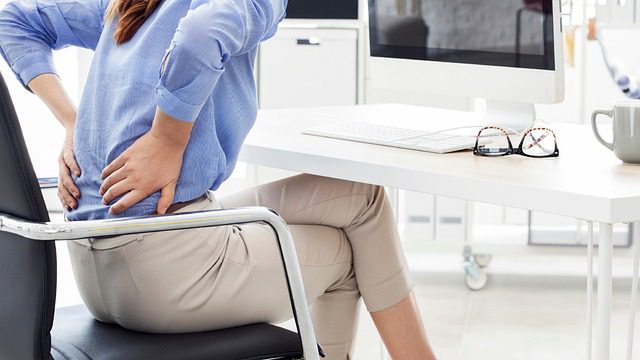

How a Sedentary Lifestyle Is Fueling Your Back Pain
A sedentary lifestyle, characterized by long periods of sitting or inactivity, is becoming increasingly common in today's modern world. Office jobs, excessive screen time, and lack of physical activity contribute to a rise in health issues, including chronic back pain.
In this article, we'll explore how a sedentary lifestyle is fueling your back pain and the steps you can take to alleviate discomfort and improve your overall health. We’ll discuss the following topics:
Table of Contents
What Is a Sedentary Lifestyle?
A sedentary lifestyle is characterized by little to no physical activity and excessive time spent sitting or lying down. With the rise of technology, desk jobs, and modern conveniences, people are becoming increasingly inactive, leading to numerous health risks and challenges.
A sedentary lifestyle is typically marked by the following behaviors:
- Prolonged sitting
- Lack of exercise
- Low energy expenditure
- Limited active hobbies
A sedentary lifestyle can have serious health consequences, including:
- Increased risk of chronic diseases: A lack of physical activity is linked to an increased risk of developing heart disease, type 2 diabetes, certain cancers, and obesity.
- Poor mental health: Sedentary behavior has been associated with an increased risk of depression, anxiety, and other mental health issues.
- Weakened bones: A sedentary lifestyle can decrease bone density, increasing the risk of osteoporosis and fractures.
- Reduced life expectancy: Research has shown that a sedentary lifestyle can decrease overall life expectancy and increase the risk of premature death.
Muscle imbalances and pain: Prolonged sitting and inactivity can lead to muscle imbalances, poor postures, and chronic pain, such as back and neck pain.
How a Sedentary Lifestyle Is Causing Your Back Pain

A sedentary lifestyle, characterized by extended periods of inactivity and sitting, can significantly contribute to back pain through various mechanisms, which we will explore in greater detail below.
Prolonged sitting and spinal disc degeneration
When you sit for long periods, the pressure on your spinal discs increases, which can lead to disc degeneration. Spinal discs comprise a tough outer layer (annulus fibrosus) and a soft, gel-like inner layer (nucleus pulposus). These discs serve as shock absorbers, providing cushioning and flexibility to the spine.
Prolonged sitting places constant pressure on the discs, causing them to lose water content and their natural elasticity. Over time, this can make the discs thinner and less capable of absorbing shock. This degeneration can cause the vertebrae to grind against each other, leading to pain and inflammation.
Muscular imbalances and postural issues
A sedentary lifestyle can lead to muscular imbalances, exacerbating back pain. Sitting for extended periods, specific muscles, such as the hip flexors and hamstrings, can become tight and overworked, while other muscles, like the glutes and core muscles, can weaken.
These imbalances can lead to poor posture, causing the spine to deviate from its natural curvature. For example, tight hip flexors can tilt the pelvis forward, increasing the lumbar spine curve and placing additional stress on the lower back. This extra strain can contribute to back pain and further exacerbate existing issues.
Nerve compression
Prolonged sitting, especially in a slouched position, can compress the nerves in the lower back. This compression can lead to sciatica, characterized by pain, numbness, or tingling radiating from the lower back down the legs. Sciatica occurs when the sciatic nerve, the largest nerve in the body, becomes irritated or pinched, often due to disc herniation or spinal stenosis.
Reduced blood flow and nutrient delivery
A sedentary lifestyle can reduce blood flow to the spinal discs and surrounding tissues. Adequate blood flow is crucial for delivering nutrients and oxygen to these structures and removing waste products. When blood flow is restricted, the health of the spinal discs and other tissues can be compromised, leading to degeneration and inflammation, which can contribute to back pain.
Weight gain and increased spinal load
A sedentary lifestyle often contributes to weight gain and obesity, as individuals tend to expend fewer calories when inactive. Carrying extra weight stresses the spine, especially the lumbar region. This increased load can accelerate disc degeneration and increase the risk of developing back pain.
Psychological factors
A sedentary lifestyle can also contribute to psychological factors like stress, anxiety, and depression. These emotional states can exacerbate back pain by increasing muscle tension and reducing the body's natural pain-relieving mechanisms. Chronic stress, for example, can cause the release of stress hormones like cortisol, which can increase inflammation and contribute to muscle tightness and pain.
Other Reasons Why Your Back Hurts

In addition to a sedentary lifestyle, there are several other common reasons your back might hurt. Some of these include:
- Muscle strain or ligament sprain: Overexertion, improper lifting techniques, or sudden movements can lead to muscle strains or ligament sprains in the back. These injuries can cause pain, inflammation, and muscle spasms.
- Herniated or bulging disc: A herniated or bulging disc occurs when the soft inner layer of the spinal disc pushes through the tougher outer layer. This can pressure nearby nerves, causing pain, numbness, or tingling in the back or extremities.
- Osteoarthritis: Osteoarthritis is a degenerative joint disease that affects the cartilage in the joints, causing them to wear down over time. In the spine, this can lead to the formation of bone spurs and reduced mobility, resulting in pain and stiffness.
- Spinal stenosis: Spinal stenosis is a spinal canal narrowing, which can compress the spinal cord or nerve roots. This compression can cause pain, numbness, or weakness in the back and extremities.
- Scoliosis: Scoliosis is an abnormal curvature of the spine that can place uneven pressure on the spinal discs, muscles, and ligaments. Scoliosis can cause mild to severe back pain depending on the curvature's severity.
- Degenerative disc disease: As part of the natural aging process, spinal discs can lose their elasticity and ability to absorb shock. This degeneration can lead to chronic pain and stiffness in the back.
- Spondylolisthesis: Spondylolisthesis occurs when one vertebra slips forward over the vertebra below it. This misalignment can compress nerves and cause back pain, numbness, or weakness in the legs.
- Infection: In rare cases, a bacterial infection in the spine, known as discitis or osteomyelitis, can cause back pain. This condition requires prompt medical attention and treatment with antibiotics.
- Tumors: Although rare, spinal tumors can develop and cause back pain. Depending on the type and severity, these tumors can be benign or malignant and may require surgical intervention or other treatments.
- Kidney stones or infections: Kidney disease symptoms often testify about kidney-related issues, such as kidney stones, and infections that can sometimes cause pain in the lower back due to the proximity of the kidneys to the spine.
- Pregnancy: Pregnant women often experience back pain due to the additional weight and hormones that stress the spine and muscles.
It is important to remember that you must consult a healthcare professional if you are experiencing persistent or severe back pain. Determining the underlying cause of your back pain and having a proper diagnosis can guide appropriate treatment, prevent further complications, and help you maintain a healthy and active lifestyle.
Lifestyle Changes to Manage Back Pain

Making lifestyle changes can significantly help manage and prevent back pain. Here are some suggestions for lifestyle adjustments that may alleviate discomfort and improve overall spinal health:
Exercise regularly
Engage in low-impact exercises like walking, swimming, or cycling to improve circulation, strengthen muscles, and increase flexibility. Incorporate strength training and core-strengthening exercises to support the spine and reduce the risk of injury.
Maintain proper posture
Practice good posture while sitting, standing, and walking. Use ergonomic chairs and ensure that workstations are set up correctly to minimize strain on the back. Keep your weight evenly distributed and your shoulders back and relaxed when standing.
Stretch regularly
Stretching your muscles, particularly those in the back, neck, hips, and hamstrings, may help to improve flexibility and alleviate muscle tension. Incorporate stretching into your daily routine and take breaks to stretch and move.
Manage stress
Chronic stress can contribute to muscle tension and back pain. Practice stress management techniques such as deep breathing exercises, meditation, yoga, or engaging in hobbies that bring relaxation and enjoyment.
Maintain a healthy weight
Carrying excess weight puts additional stress on the spine and back muscles. Adopt a balanced diet and regular exercise routine to help maintain a healthy weight and reduce the risk of back pain.
Quit smoking
Smoking can restrict blood flow, reducing oxygen and nutrient delivery to spinal tissues. Quitting smoking can improve overall health and reduce the risk of back pain.
Lift properly
Use proper lifting techniques to avoid straining your back muscles. Bend at your knees, keep your back straight, and engage your core muscles when lifting heavy objects. Avoid twisting your body while lifting.
Sleep well
Ensure that your sleeping environment is supportive of your back. Use a firm mattress and pillows that adequately support your neck and spine. Try to sleep in a position that maintains the natural curve of your spine.
Wear supportive footwear
Choose shoes with good arch support and cushioning to help maintain proper posture and reduce strain on your back.
Conclusion
A sedentary lifestyle has become increasingly common in modern society and significantly contributes to back pain. Prolonged sitting, poor posture, muscular imbalances, nerve compression, reduced blood flow, weight gain, and psychological factors all play a role in exacerbating back pain in individuals who lead a sedentary lifestyle.
Addressing the negative impact of a sedentary lifestyle on your back requires a multifaceted approach, including regular exercise, stretching and strengthening, taking breaks during periods of prolonged sitting, and maintaining proper ergonomics at work.
By consciously incorporating these healthy habits into your daily routine, you can help prevent and alleviate back pain, improve your overall spinal health, and enhance your quality of life. Consulting a healthcare professional is essential for accurately diagnosing and treating persistent or severe back pain.
About Dr. Sean Ormond



